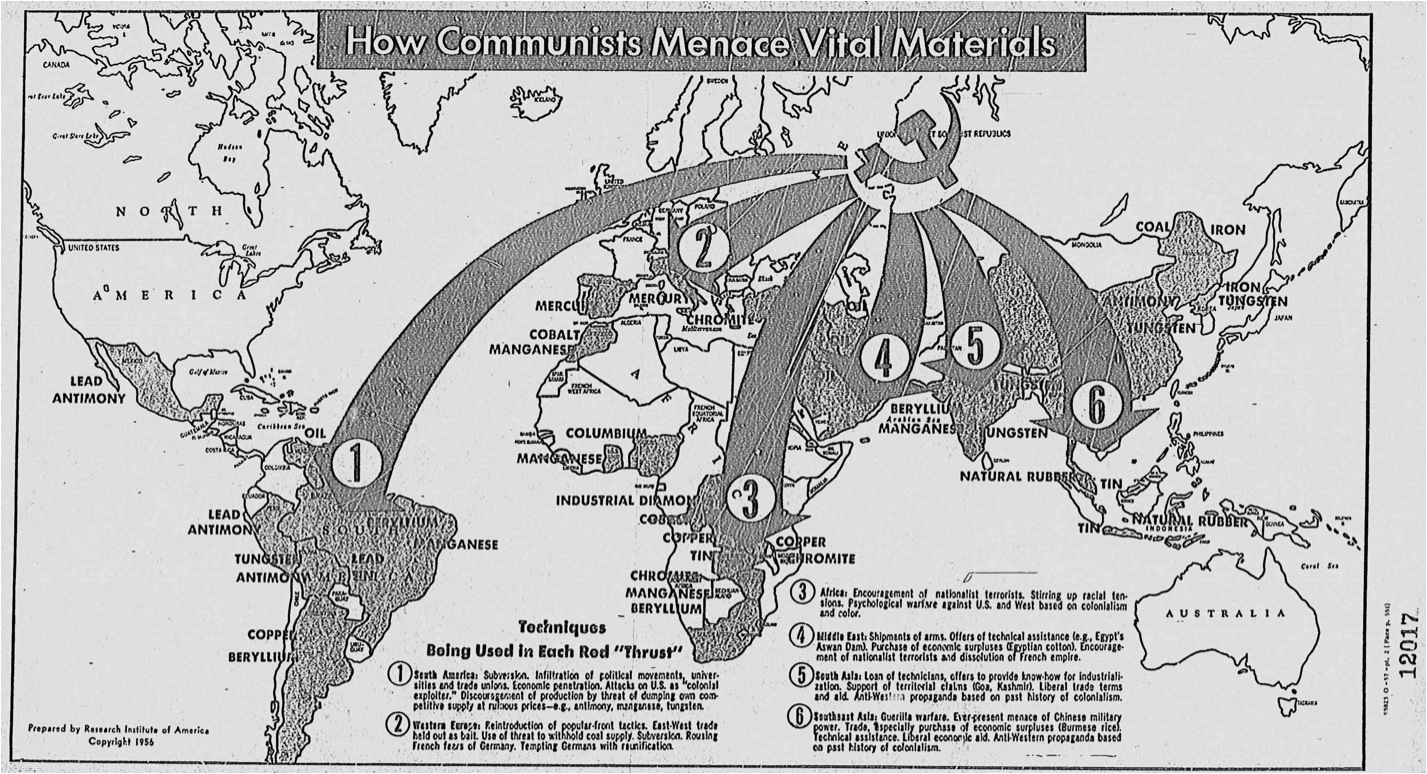Source: https://blackboard.richmond.edu/bbcswebdav/pid-1007588-dt-content-rid-1115813_1/courses/201310_13467/Great%20Pretense%20HUAC%20Report.pdf
“How Communists Menace Vital Materials” (1956), by the Research Institute of America and released by the HUAC (House of Un-American Activities Committee), came out during the very heart of the Cold War. This map comes from an early think-tank, the RIA, in which they brainstormed ways the USSR could take economic control over the world. To comprehend what was happening during the time the map was released; one also needs to be conscious of the events that lead up to this time period. At the end of World War II in 1945, the US and the Soviet Union emerged as world leaders. The two superpowers were wary of each other, however, instead of collaborating to help rebuild countries devastated by the war, tensions continued to rise. Conferences between the US and the USSR in Yalta and Potsdam only further strained relations. In 1947, the US became involved in the Greek Civil War. This is often considered the beginning of the Cold War, as American troops were deployed to fight off communist guerrillas to contain communism in the east. Also in 1947, the US issued the Marshall Plan and the Truman Doctrine. The former gave aid to European countries crippled by the war in the hopes of rebuilding their economies and promoting trade. The latter gave economic aid specifically to Greece and Turkey so they could resist the pulls of communism.
Thus far, the war had been highly conceptual for the majority of Americans—“we” were fighting an idea (communism) rather than countries as in WWII. However, in 1949, the Soviet Union detonated its first atomic bomb, sending the Cold War into full effect. Now there was a possibility—at least in people’s minds—that the US was in danger even on home soil. Thus began the arms race component of the Cold War. The US developed its first hydrogen bomb in 1952, but three years later the USSR had accomplished the task as well. Terror gripped the nation, and various methods of propaganda were used to scare the nation further and condemn communism.
In order to fully understand the context in which the map arises, one needs to be aware of the various ways in which the countries, especially the US and USSR, were being affected. In the 1950s, the arms race was hitting its peak, but beyond the military action being taken, there was also a cultural and economic expansion as well. More specifically, in the US and USSR, new organizations were being created such as the KGB and NASA. The new formations apart of the “age of information” were becoming the norm and an ideological competition came to fruition. Competition was not limited to solely political or social means, but also to economic ones as well. In this map, one can see the global reach the USSR had on the world. The idea of a closed globe comes into play because realistically, there was no place in the world the Soviet Union could not take a hold on. Their reach looks similar to that of a hand reaching and grabbing each country for its resources.
At the heart of every conquest lies economic motive. During the Cold War this idea was no exception. America had its eye on stopping the spread of Communism. In addition, however, America also had its eye on the economic value of the world. On this map, every country has a list of natural resources instead of the actual names of the country. This was not a map focused on military power, but rather of the possible economic power and global reach of the USSR. The RIA, creators of the map, thought of six major ways in which the Soviet Union could accomplish global economic power. The first method of “dumping”, used in South America, was the threat the USSR would sell all of their own similar resources at very low prices to destroy the economies in this area. The second method in Western Europe was trade threats and the threat of reunification of Germany. Third, the threat was support of terrorist regimes and colonialism in Africa. Fourth, the USSR would ship arms and take economic surplus in the Middle East. Fifth, in South Asia the USSR would industrialize and lay territorial claims on the area. Sixth, in Southeast Asia the USSR would provoke guerilla warfare and display western propaganda to take hold on the region. There were a number of ways in which the USSR could take control and the US and congress needed to be aware of these facts.
Although the map is not as detailed as other maps of the time, it still serves a purpose in the backdrop of the Cold War. While this map is a form of propaganda, this map also shows very relevant information and the importance of stopping the spread of Communism, in regards to the US economy. In noting the resources and reach of the Soviet Union, the interests of the US around the world can also clearly be shown. This map does not just put a country’s name and color it in red for symbolism of USSR control. It instead denotes the economic importance of the globe as a whole, and what resources could or could not be lost if the US fails to intervene during the Cold War.
-Sophie Holmes, Carl Johnson
Works Cited
RIA, “How Communists Menace Vital Materials”
“Soviets Explode Atomic Bomb.” History.com. A&E Television Networks, n.d. Web. 26 Oct. 2013. <http://www.history.com/this-day-in-history/soviets-explode-atomic-bomb>.
“The Cold War.” The Cold War. N.p., n.d. Web. 26 Oct. 2013. <http://www.historylearningsite.co.uk/coldwar.htm>.

